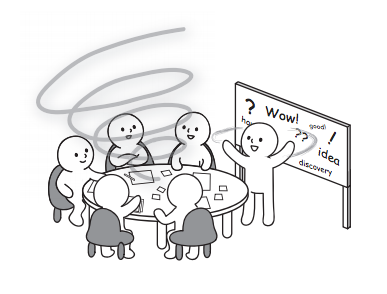Generative Participant/OG
| Generative Participant | |
| Contributors | Takashi Iba, Chikara Ichikawa, Mami Sakamoto, Tomohito Yamazaki |
|---|---|
| Last modification | May 17, 2017 |
| Source | Iba, Ichikawa, Sakamoto & Yamazaki (2011)[1]; Harashima, Kubota & Iba (2014)[2] |
| Pattern formats | OPR Alexandrian |
| Usability | |
| Learning domain | |
| Stakeholders | |
You are about to facilitate creative learning in the classroom, after you have designed the curriculum based on Discovery-Driven Expanding (Discovery-Driven Expanding) and the mission based on Challenging Mission (Challenging Mission). Thanks to the accumulation of learning through Discovery-Driven Expanding (Discovery-Driven Expanding), the learners feel easy to say their ideas and approve other’s ideas. Also, thanks to the series of experiences through Challenging Mission (Challenging Mission), the learners are ready to cope with the difficulty of the mission.
Communication for the collaboration doesn’t always go smoothly, and often stops and sometimes falls into the situation where a very few members control the flow and others follow it. In such a situation, teachers’ direct control of the flow often inhibits creative learning, and therefore learning through creation does not occur. This problem has been discussed for a long time in the study of collaborative learning such as in Palincsar et al.[3]. The most important point of creative learning is successive emergence of discoveries. So learners must continue to produce discoveries not by thinking but also by communication.
Consider you as a participant in the activity rather than a teaching actor, who contributes to produce some of discoveries in the creation and also encourage your partners (learners) to think and communicate. More concretely, tell your ideas, opinions such as “Oh! That’s a nice idea!” and questions such as “Do you mean ...?”, which assist to accelerate the flow of communication and reconsider their ideas. It does not mean the control of the flow from outside. Rather, it is the influence from inside.
Learners can keep concentration into the creation and feel the progress, and therefore they learn through the creation.
Moreover, learners become to deeply understand the value of collaboration with others, so to be willing to enjoy creative dialogues.
For instance, C. Ichikawa participates into his class entitles “Future Funeral” at the Tokyo Community School based on Generative Participant. Since it is quite difficult for children to imagine their future concretely how and what they will be thirty years later, he first shows an example of chronology of his future. It includes many things such as good, bad, proud and shame things frankly, and he presented to them, and inspires the students to make their own chronology. In the halfway of writing, he has students give a presentation about their chronology to each other, and brush-up their chronology. In all phases, he tells his ideas, opinions and questions in order to assist to accelerate the flow of communication and reconsider their ideas.
References
- ↑ Iba, T., Ichikawa, C., Sakamoto, M., & Yamazaki, T. (2011). Pedagogical patterns for creative learning. In Proceedings of the 18th Conference on Pattern Languages of Programs (PLoP 2011) (p. 28). New York:ACM.
- ↑ Mentioned in Harashima, Y., Kubota, T., & Iba, T. (2014). Creative education patterns: designing for learning by creating. In Proceedings of the 19th European Conference on Pattern Languages of Programs (EuroPLoP 2014) (p. 7). New York:ACM.
- ↑ Palincsar, A. S., Brown, A. L., & Martin, S. M. (1987). Peer interaction in reading comprehension instruction. Educational psychologist, 22(3-4), 231-253.
